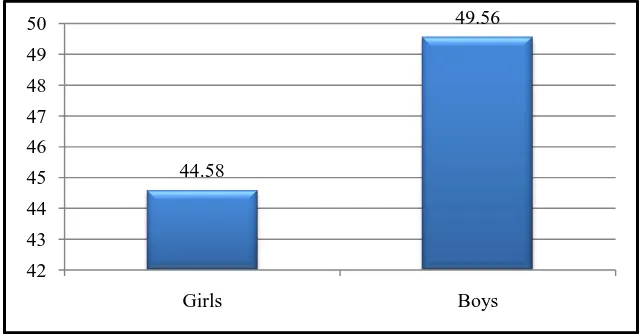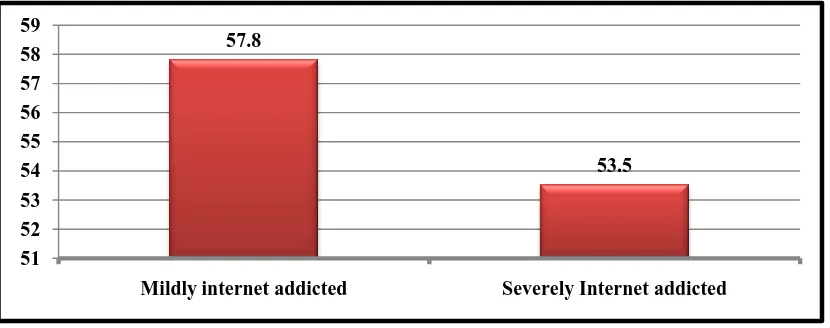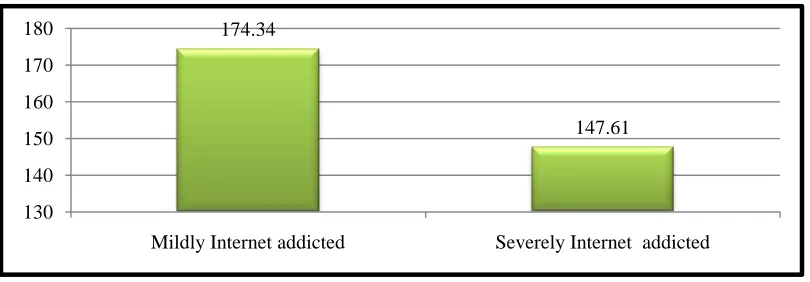© Associated Asia Research Foundation (AARF)
A Monthly Double-Blind Peer Reviewed Refereed Open Access International e-Journal - Included in the International Serial Directories.
Page | 122
INFLUENCE OF INTERNET ADDICTION ON MENTAL HEALTH AND
ADJUSTMENT OF COLLEGE STUDENTS
Dr. Vinita M. Chaudhary
Assist. Prof. (New Era College of Science & Tech. Gzb.)
ABSTRACT
Internet is a ‘network of networks’ that links computers around the world. It is a network of millions of computers across the world and thereby it is the immense collection of resources people, information and multimedia. After the invention of computer the world has become a global village. On one hand information revolution in cyber age has so many positive characteristics that make human life so comfortable but on the other hand the adverse effect of Internet has also been identified which may be known as compulsive, Internet usage or Internet Addiction Disorder (IAD) or cyber space addiction or pathological computer use. These initial impacts have varied influence on different on different people with respect to their self concept, body image, mental health, and adjustment etc, through cognition.
INRODUCTION:
Internet is a „network of networks‟ that links computers around the world. It is a network of
millions of computers across the world and thereby it is the immense collection of resources
people, information and multimedia. After the invention of computer the world has become a
global village. On one hand information revolution in cyber age has so many positive
characteristics that make human life so comfortable but on the other hand the adverse effect of International Research Journal of Human Resources and Social Sciences
ISSN(O): (2349-4085) ISSN(P): (2394-4218) Impact Factor- 5.414, Volume 5, Issue 01, January 2018 Website- www.aarf.asia, Email : editor@aarf.asia , editoraarf@gmail.com
© Associated Asia Research Foundation (AARF)
A Monthly Double-Blind Peer Reviewed Refereed Open Access International e-Journal - Included in the International Serial Directories.
Page | 123
Internet has also been identified which may be known as compulsive, Internet usage or Internet
Addiction Disorder (IAD) or cyber space addiction or pathological computer use. These initial
impacts have varied influence on different on different people with respect to their self concept,
body image, mental health, and adjustment etc, through cognition.
NEED OF THE STUDY: Rapid growth and easy access to the Internet has facilitated its influence on the way of life of people. It causes psychological and interpersonal problems in a
person‟s life. The research in this area is very much needed to identify the impact of Internet
addiction on mental health and adjustment of students.
SIGNIFICANCE OF THE STUDY: Internet addicted students face Psychological problems, academic problems and health problems among them decreases of self esteem is one of the
problem of Internet addiction. Mental health is the ability to balance feelings, desires, ambitions
and ideas in one‟s life. It means the ability to face and concept the realities of life. On the other
hand adjustment is a continuous process by which a person varies his behavior to establish a
harmonious relationship between himself and his environment. This study is to find out the
impact of Internet addiction on the mental health and adjustment of college students and it helps
to become aware of the problems of Internet addiction.
STATEMENT OF THE PROBLEM: “Influence of Internet Addiction on Mental health and
adjustment of college students”.
OBJECTIVES OF THE STUDY: The study has the following objective:
1. To study the Internet addiction of college students.
2. To find out significant difference in Mental Health of mildly Internet addicted and severely Internet addicted college students.
HYPOTHESES: The study has the following hypotheses:
1. There will be no significant difference in Mental Health of mildly Internet addicted and severely Internet addicted college students.
© Associated Asia Research Foundation (AARF)
A Monthly Double-Blind Peer Reviewed Refereed Open Access International e-Journal - Included in the International Serial Directories.
Page | 124 DELIMITATION: Due to Short time and resources the research delimited the problem in following ways:
1. The study is confined only to professional college students.
2. The study is confined to professional colleges of Ghaziabad district only.
3. The present study is delimited to measures only six aspects of mental health.
4. The study is confined to higher classes only.
METHODOLOGY OF THE STUDY: There are several research methods but here, the researcher used ex-post-facto method to explore. Influence of Internet addiction on mental health
of students. Ex-post-facto research has characteristics of descriptive co relational and
experimental research. The casual comparative or ex-post-facto method attempts to deduce or
discover “how and why” a particular phenomenon occurs.
POPULATION AND SAMPLE: The study has the following sampling procedure:
1. Population: The population of study consists of all the students pursuing graduation and post-graduation in professional college of Ghaziabad District.
2. Sampling: It is a sure quo none of research. It implies the selection or drawing of a portion from the mass or whole of something. Random selection technique was used to collect the
data by researcher.
First of all a list of all government and self-financed professional colleges was prepared with the
help of Internet and then two professional colleges of Ghaziabad District were selected randomly
© Associated Asia Research Foundation (AARF)
A Monthly Double-Blind Peer Reviewed Refereed Open Access International e-Journal - Included in the International Serial Directories.
Page | 125 Fig:1- Sample Selection Strategy
VARIABLE: The present study has focused on three variables:
Dependent Variable Independent Variable
Mental Health Adjustment
Internet Addiction
TOOLS EMPLOYED IN STUDY: To measure the different variable i.e. Internet Addiction, Mental health and Adjustment the following instrument (tools) have been used in the present
study.
1. “Mental Health Battery (MHB)” constructed by Arun Kumar singh and AlpanaSen Gupta. 2. “Adjustment Inventory” by V.K.Mittal.
3. "Internet Addiction Questionnaire” constructed by Dr. Kimberley Young to find out the
Internet Addiction among college Students.
List of All Professional colleges of District Ghaziabad
Two Professional College of Ghaziabad
All II, III, IV year Students (N=150)
All II, III, IV year Students (N=150)
Internet Addicted Students N=100
© Associated Asia Research Foundation (AARF)
A Monthly Double-Blind Peer Reviewed Refereed Open Access International e-Journal - Included in the International Serial Directories.
Page | 126 SCORING:
Scoring is simple. Every category of response is given a score. Maximum score to be given on an
item is .This is indicated by colored hole on the scoring stencil. Doubtful response is always to
be scored as 2 and the score on the rest of the items is 1. There are separate scoring stencils for
each page area wise. Put the appropriate area key on the test sheet and see how many responses
are encircled in colored punch of the stencil. Count such responses for each page and multiply
that number by 3. Then count encircled responses in.? (Doubtful category) and multiply that
number by 2. Then count the rest of the encircled responses. Add all the scores obtained for a
particular area for all the pages. This will give you the area score. Record total area score so
obtained on the cover page of the Inventory. Total the scores obtained for all the areas to get the
over-all Adjustment score.
1) Maximum possible scores on the Inventory.
2) Minimum Possible scores on the Inventory.
STATISTICAL TECHNIQUES: The data was analyzed statistically by using Mean, Standard Deviation, and t-test .Mean is sensitive measure of sample or group. It is the most accurate
measure of central tendency .It is used for interval and ratio variable.
TEST OF SIGNIFICANCE: To study the variation in the scores of Internet addiction, Mental Health and adjustment Standard deviation was calculated.
DATA ANALYSIS: Tabulation is the process of transferring classified data from data gathering tools to the tabular form in which they may be systematically examined analysis of data means
studying organized material in order to discover in the facts.
© Associated Asia Research Foundation (AARF)
A Monthly Double-Blind Peer Reviewed Refereed Open Access International e-Journal - Included in the International Serial Directories.
[image:6.612.152.462.65.245.2]Page | 127 Table 1: Showing percentage of Internet Addiction in Boys & Girls.
Category N Mean S.D.
Percentage (%) of
Mild Moderate Severe
Girls 50 44.58 10.41 32 30 38
Boys 50 49.56 13.08 40 10 50
Total Students 100 47.02 14.75 36 20 44
The above table reveals that average students are moderately internet addicted 32% girls are
mildly internet addicted, 30% girls are moderately internet addicted and 38% girls are severely
internet addicted on the other hand, 40% boys are mildly internet addicted, 10% boys are
moderately internet addicted, while, 50% boys are severely internet addicted. As the mean of
boys is higher than the girls, this clearly indicates that boys are more internets addicted in
comparison to the girls.
Fig 2: Showing percentage of Internet Addiction in Boys & Girls.
MENTAL HEALTH OF STUDENTS: Students Mental Health was studied by applying Mental Health battery and all dimensions were studied separately.
44.58
49.56
42 43 44 45 46 47 48 49 50
[image:6.612.147.469.390.557.2]© Associated Asia Research Foundation (AARF)
A Monthly Double-Blind Peer Reviewed Refereed Open Access International e-Journal - Included in the International Serial Directories.
Page | 128 Hypothesis 1: There will be no significant difference in mental health of mildly internet addicted and severely internet addicted students.
Table 2: Showing Mean, S.D. and‟t‟ values of mild internet addicted and severely internet addicted students.
Groups N Total Mean Value of Mental Health S.D. T
Mildly internet addicted 36 57.8 8.9 1.69
Severely Internet addicted 44 53.5 9.7
Above table reveals that Mean value of mildly internet addicted students is 57.8 and mean value
of severely internet addicted students is 53.5. Thus, it can be interpreted that the Mildly Internet
addicted students are more mentally healthy in comparison to the severely internet addicted
[image:7.612.98.517.140.183.2]students.
Fig.3: Showing difference between mildly internet addicted and severely internet addicted with regard to mental health.
ADJUSTMENT OF STUDENTS: Students adjustment was studied by applying adjustment Inventory
Hypothesis 2: There will be no significant difference in level of adjustment of mildly internet addicted and severely internet addicted. To test this hypothesis, 't' test was used. The following
table shows the result in this relation.
57.8
53.5
51 52 53 54 55 56 57 58 59
[image:7.612.102.517.287.451.2]© Associated Asia Research Foundation (AARF)
A Monthly Double-Blind Peer Reviewed Refereed Open Access International e-Journal - Included in the International Serial Directories.
[image:8.612.118.494.56.164.2]Page | 129 Table 3: Showing result of adjustment of mildly internet addicted and severely internet addicted
Groups N Total Mean Value of Adjustment S.D. „t‟
Mildly Internet addicted 36 174.34 14.22
1.71 Severely Internet addicted 44 147.61 18.51
Above table reveals that Mean Value of Mildly internet addicted students is 174.34 and Mean
value of severely internet addicted students is 147.61. Thus, it can be interpreted that the mildly
internet addicted students are more adjusted in comparison to the internet addicted students.
Fig 4: Showing percentage of adjustment in mildly internet addicted & severely internet addicted.
FINDINGS OF THE STUDY: Findings of the present study are given according to the objectives and concerning hypothesis mentioned below:
INTERNET ADDICTION OF STUDENTS: The results indicate that average students are moderately internet addicted and boys are more severely internet addicted in comparison to girls
32% girls are mildly internet addicted, 30% girls are moderately internet addicted and 38% girls
are severely internet addicted. While 40% boys are mildly internet addicted, 10% boys are
moderately internet addicted, while 50% boys are severely internet addicted. Thus, it can be
concluded that boys are more rigorously internet addicted than girls. The reason behind this may
be that boys have less commitment at home when compared to the girls. Hence they spend more
time for Internet usage even at home.
174.34
147.61
130 140 150 160 170 180
[image:8.612.106.511.248.389.2]© Associated Asia Research Foundation (AARF)
A Monthly Double-Blind Peer Reviewed Refereed Open Access International e-Journal - Included in the International Serial Directories.
Page | 130 H1: MENTAL HEALTH OF STUDENTS: The result indicates that mildly internet addicted students are mentally healthier in comparison to severely internet addicted students. It is
supported by Jerald J. Block, M.D. Hilarie Cash, Kim Mc Daniel that Internet addictions
symptoms exhibited diagnosable mental health disorders and found that brain structural was
present in severely addicts.
H2: ADJUSTMENT OF STUDENTS: The result indicates that mildly internet addicted students are well adjusted in comparison to severely internet addicted students. It is supported by
David Greenfield, that internet addiction induces dissociation, time distortion and instant
gratification and adjustment problems. It is supported by Chih-Hung Kos MD, Ju-Yu Yen that
Internet Gaming addiction was significantly correlated to real ideal, self discrepancy, current
wood, and peer relationship.
EDUCATIONAL IMPLICATIONS: Educational research is a systematic attempt to gain a better understanding of educational process generally with a view to improve its efficiency,
research is of no value until its findings are applied for anything that may have some practical
importance. Certain educational implications can also be derived from the findings of the present
investigator. These are given below.
Now a day‟s internet is taking place of teacher. It is impossible to have a teacher available
every time and everywhere to resolve the queries of the students. So if student are habitual of
internet surfing they can resolve their queries. Themselves and find many solutions to a
single problem using internet save time and money also.
If students use internet the use of paper will decrease resulting in the decrease of cutting of
trees.
The shortage of teachers would itself be fulfilled by use of internet by students to help them
in studying.
There would not be any time limit for learning new things and student would be able to get
latest information and knowledge in the era of globalization.
© Associated Asia Research Foundation (AARF)
A Monthly Double-Blind Peer Reviewed Refereed Open Access International e-Journal - Included in the International Serial Directories.
Page | 131
1) Majority of the students use the internet to pass time, by surfing or chatting. This is a
dangerous indication. Educationist, counselors or teachers and parents should motivate
students to use the internet as an information superhighway for visiting cyber-cafes.
2) Students should be encouraged to use the internet at educational institutions instead of
visiting cyber cafes.
3) Internet enables a person to forget the real world. It is the duty of Parents teachers to
bring students back to the real world with its real problem.
SUGGESTIONS FOR THE FURTHER RESEARCH: In order to draw the plan for further researches in the thirsty area of Influence of Internet addiction on mental health and adjustment
of college students, some suggestion are presented here.
1) The Present study was confined to a large sample of the students. It is desired that a
similar study should be carried out on a small sample.
2) The attitude of students towards internet should be investigated.
3) The research can be done in the vocational courses also.
4) The research can be done in other districts and states also.
CONCLUSION: Internet has become an indispensable tool in business and academic and personal use is increasing every day. For better or worse, Internet has infiltrated every aspect of
our lives. Society has reached such a level that it is difficult rather impossible to live without the
Internet. Moreover college students are the greater users of the Internet. Excessive use of the
Internet leads the students to become addicts and affect the psychology of the students. In fact
the present study concluded that greater use of the Internet leads to decrease the mental health
and adjustment level among college students. Hence Internet addiction and mental health and
Internet and adjustment are closely related. It can also be stated Internet plays a major role in the
psychology of the students.
REFERENCES
1. http://webology.ir/2005/v2 n4/a21. html.
2. http://usa online colleges.com./articles-about-usa-online-colleges/study habits-for-online
© Associated Asia Research Foundation (AARF)
A Monthly Double-Blind Peer Reviewed Refereed Open Access International e-Journal - Included in the International Serial Directories.
Page | 132
3. http://www.selfgrowth.com/articles/very.html.
http://www.phoeniz/herts.ac.uk.sdru/Helen/Unterhtml.
4. http://www.crito./vci.edu/TLC/findings/Internet.Use/starpage.html.


